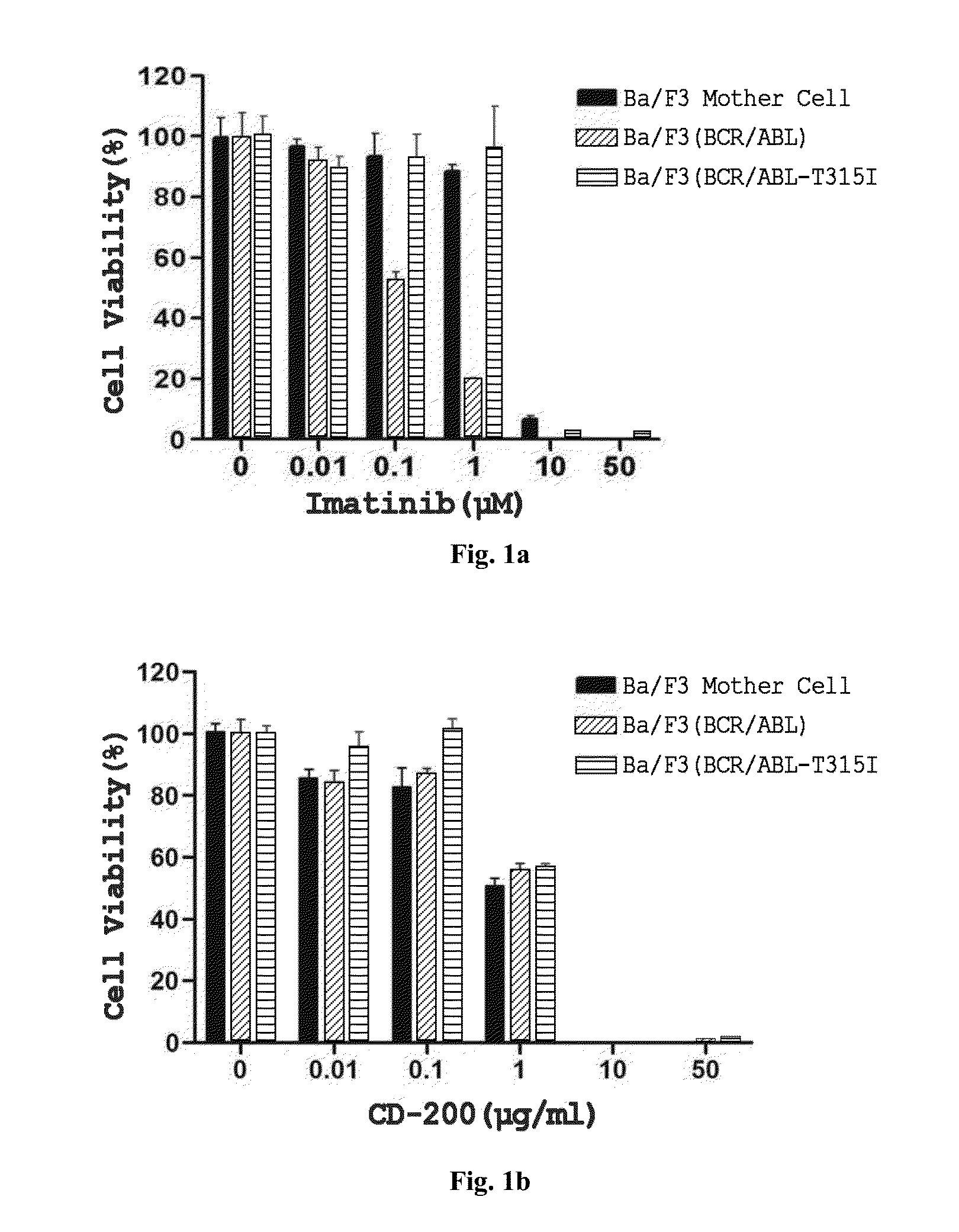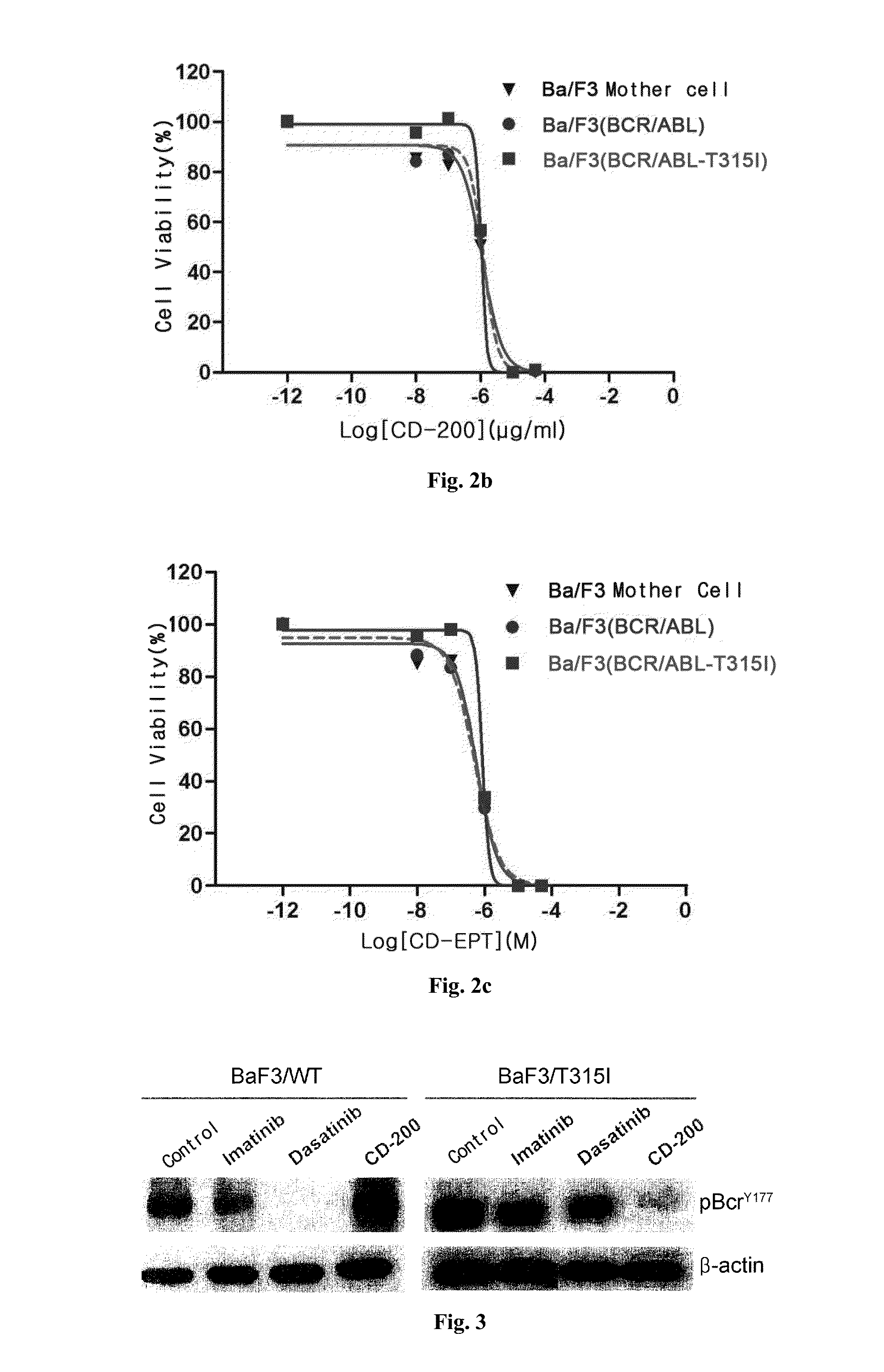Pharmaceutical composition containing liriodendron tulipifera l. extract for treating chronic myelogenous leukemia
a technology of liriodendron tulipifera and composition, which is applied in the direction of drug compositions, biocide, plant/algae/fungi/lichens ingredients, etc., can solve the problems of abnormal myeloid cells appearing to be mature, the inability to play the role of normal myeloid cells, and the inability to achieve the blood-based function
- Summary
- Abstract
- Description
- Claims
- Application Information
AI Technical Summary
Benefits of technology
Problems solved by technology
Method used
Image
Examples
preparation example 1
Preparation of Extract (CD-200) from Bark of Liriodendron tulipifera
[0056]1. Solvent Extraction Step
[0057]200 g of dried and chopped bark of 3-5 years old Liriodendron tulipifera has been agitated and extracted using 2000 ml of ethyl acetate at room temperature for 24 hours. After concentrating and filtering the extracted mixture at reduced pressure, the preliminary extract has been obtained. The obtained preliminary extract has been further mixed and extracted using 500 ml of butanol at room temperature for 2-4 hours. Then, the butanol soluble materials have been removed by separating and removing the butanol layer. Finally, 12.54 g of crude extract has been obtained after concentrating the remained mixture.
[0058]2. Purification Step
[0059]After dissolving 12.54 g of obtained crude extract with 200 ml of 70% ethanol, 200 ml of n-hexane has been added and agitated to the crude extract mixture. After separating and removing the n-hexane layer, 70% ethanol layer has been obtained. Fin...
preparation example 2
Preparation and Isolation of Epi-Tulipinolide Component (CD-EPT) from Bark of Liriodendron tulipifera as a Main Component of CD-200
[0060]The component of epi-tulipinolide has been isolated from the extract (CD-200) from bark of Liriodendron tulipifera using high performance liquid chromatography (HPLC) Alliance e2695 system by WATERS. The conditions for HPLC analysis are as follows. Reverse phase column Kromasil C18 has been used, 5 mg / ml of sample has been loaded and 215 nm of UV wave length (flow rate: 1.0 ml / min) has been employed for measuring the amount of eluent. Further, the mobile phase gradient (water and methanol) condition has been employed. Finally, the component of epi-tulipinolide has been isolated from the fraction at retention time=˜31 minutes. The extract has been named as CD-EPT.
preparation example 3
Isolation and Identification of Epi-Tulipinolide (CD-EPT)
[0061]The identification of epi-tulipinolide in the obtained fraction has been measured by the comparison of retention time, after loading and passing both sample of fraction and sample of standard epi-tulipinolide through the HPLC column. Then, it has been confirmed that the components of obtained fraction chiefly consist of epi-tulipinolide, since both retention times of obtained fraction and epi-tulipinolide have been measured to be same. Further, the specific rotation of epitulipinolide has been measured. The measured value of epi-tulipinolide ([α]D=+74) from CD-200 has almost corresponded with reported value of epi-tulipinolide ([α]D=+76). Therefore, the presence of epitulipinolide has been confirmed by stereochemistry.
PUM
| Property | Measurement | Unit |
|---|---|---|
| wave length | aaaaa | aaaaa |
| Imatinib resistance | aaaaa | aaaaa |
| resistance | aaaaa | aaaaa |
Abstract
Description
Claims
Application Information
 Login to View More
Login to View More - R&D
- Intellectual Property
- Life Sciences
- Materials
- Tech Scout
- Unparalleled Data Quality
- Higher Quality Content
- 60% Fewer Hallucinations
Browse by: Latest US Patents, China's latest patents, Technical Efficacy Thesaurus, Application Domain, Technology Topic, Popular Technical Reports.
© 2025 PatSnap. All rights reserved.Legal|Privacy policy|Modern Slavery Act Transparency Statement|Sitemap|About US| Contact US: help@patsnap.com



